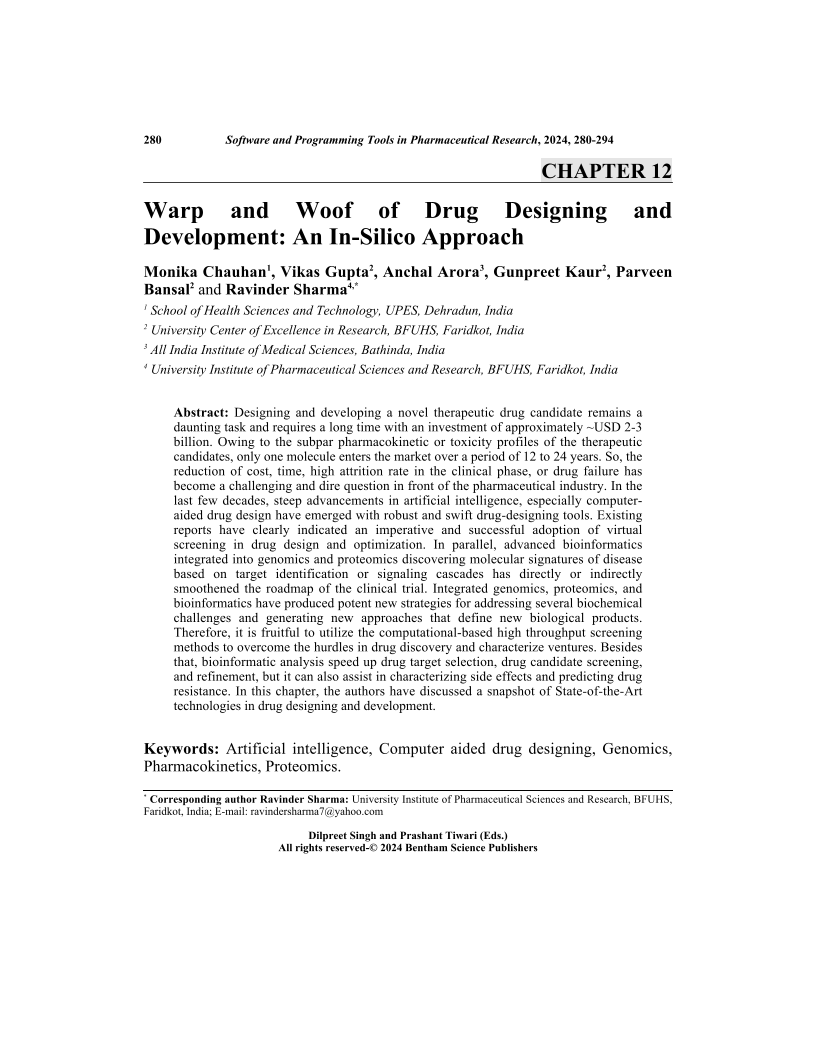Warp and Woof of Drug Designing and Development: An In-Silico Approach

- Authors: Monika Chauhan1, Vikas Gupta2, Anchal Arora3, Gunpreet Kaur4, Parveen Bansal5, Ravinder Sharma6
-
View Affiliations Hide AffiliationsAffiliations: 1 School of Health Sciences and Technology, UPES, Dehradun, India 2 University Center of Excellence in Research, BFUHS, Faridkot, India 3 All India Institute of Medical Sciences, Bathinda, India 4 University Center of Excellence in Research, BFUHS, Faridkot, India 5 University Center of Excellence in Research, BFUHS, Faridkot, India 6 University Institute of Pharmaceutical Sciences and Research, BFUHS, Faridkot, India
- Source: Software and Programming Tools in Pharmaceutical Research , pp 280-294
- Publication Date: March 2024
- Language: English
Warp and Woof of Drug Designing and Development: An In-Silico Approach, Page 1 of 1
< Previous page | Next page > /docserver/preview/fulltext/9789815223019/chapter-12-1.gif
Designing and developing a novel therapeutic drug candidate remains a daunting task and requires a long time with an investment of approximately ~USD 2-3 billion. Owing to the subpar pharmacokinetic or toxicity profiles of the therapeutic candidates, only one molecule enters the market over a period of 12 to 24 years. So, the reduction of cost, time, high attrition rate in the clinical phase, or drug failure has become a challenging and dire question in front of the pharmaceutical industry. In the last few decades, steep advancements in artificial intelligence, especially computeraided drug design have emerged with robust and swift drug-designing tools. Existing reports have clearly indicated an imperative and successful adoption of virtual screening in drug design and optimization. In parallel, advanced bioinformatics integrated into genomics and proteomics discovering molecular signatures of disease based on target identification or signaling cascades has directly or indirectly smoothened the roadmap of the clinical trial. Integrated genomics, proteomics, and bioinformatics have produced potent new strategies for addressing several biochemical challenges and generating new approaches that define new biological products. Therefore, it is fruitful to utilize the computational-based high throughput screening methods to overcome the hurdles in drug discovery and characterize ventures. Besides that, bioinformatic analysis speed up drug target selection, drug candidate screening, and refinement, but it can also assist in characterizing side effects and predicting drug resistance. In this chapter, the authors have discussed a snapshot of State-of-the-Art technologies in drug designing and development.
-
From This Site
/content/books/9789815223019.chapter-12dcterms_subject,pub_keyword-contentType:Journal105

